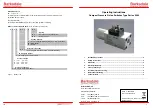
DES-3500 Layer 2 Fast Ethernet Switch CLI Reference Manual
4
..
?
clear
clear arptable
clear counters
clear fdb
clear log
clear port_security_entry port
config 802.1p default_priority
config 802.1p user_priority
config 802.1x auth_mode
config 802.1x auth_parameter ports
config 802.1x auth_protocol
config 802.1x capability ports
config 802.1x guest_vlan ports
config 802.1x init
config 802.1x reauth
config access_profile profile_id
config account
config address_binding ip_mac ipaddress
config address_binding ip_mac ports
config admin local_enable
CTRL+C
ESC
q
Quit
SPACE
n
Next Page
ENTER
Next Entry
a
All
Figure 2-2. The ? Command
When users enter a command without its required parameters, the CLI will prompt users with a
Next possible completions:
message.
DES-3500:admin#config account
Command: config account
Next possible completions:
<username>
DES-3500:admin#
Figure 2-3. Example Command Parameter Help
In this case, the command
config account
was entered with the parameter
<username>
. The CLI will then prompt users to enter
the
<username>
with the message,
Next possible completions:
. Every command in the CLI has this feature, and complex
commands have several layers of parameter prompting.
In addition, after typing any given command plus one space, users can see all of the next possible sub-commands, in sequential
order, by repeatedly pressing the
Tab
key.
To re-enter the previous command at the command prompt, press the up arrow cursor key. The previous command will appear at
the command prompt.
DES-3500:admin#config account
Command: config account
Next possible completions:
<username>
DES-3500:admin#config account
Command: config account
Next possible completions:
<username>
DES-3500:admin#
Figure 2-4. Using the Up Arrow to Re-enter a Command
In the above example, the command
config account
was entered without the required parameter
<username>
, the CLI returned
the
Next possible completions: <username>
prompt. The up arrow cursor control key was pressed to re-enter the previous








































